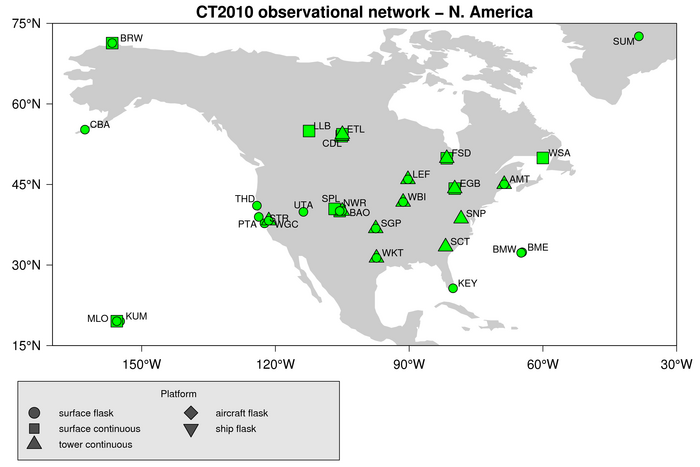To produce quantitative estimates of atmospheric methane uptake and release for North America and the rest of the world that are consistent with observed patterns of CH4 in the atmosphere.
A tool for Science, and Policy
CarbonTracker-CH4 as a scientific tool will, together with long-term monitoring of atmospheric CH4, helps to improve our understanding of how methane uptake and release from land ecosystems and oceans is responding to a changing climate, increasing levels of atmospheric CH4 and other environmental changes, including human management of land. The open access to all CarbonTracker-CH4 results means that anyone can scrutinize our work, suggest improvements, and profit from our efforts. This will accelerate the development of a tool that can monitor, diagnose, and possibly predict the behavior of the global methane cycle, and the climate that is so intricately connected to it.
Not only is it a scientific tool, CarbonTracker-CH4 has also become a policy tool. Its ability to accurately quantify natural and anthropogenic emissions and uptake at regional scales is currently limited by a sparse observational network. With enough observations, it is possible to keep track of regional emissions, including those from fossil fuel use, over long periods of time. This will provide an independent check on emissions accounting. It can thus provide feedback to policies aimed at limiting greenhouse gas emissions. This independent measure of effectiveness of any policy, provided by the atmosphere itself (where green house gas levels matter most!), is the bottom line in any mitigation strategy.

A Community Effort
CarbonTracker is intended to be a tool for the community and we welcome feedback and collaboration. Our ability to accurately track carbon and methane with greater spatial and temporal detail is dependent on our collective ability to make enough measurements and to obtain enough air samples to characterize variability in the atmosphere. For example, estimates suggest that observations from tall communication towers (>200m) can tell us about carbon uptake and emission over an area of only several hundred kilometers. The map of observation sites shows how sparse the current network is. One way to join this effort is by contributing measurements. Regular air samples collected from the surface, towers or aircraft are needed. It is also beneficial to expand use of continuous measurements like the ones now being made on very tall (>200m) communication towers. Another way to join this effort is to volunteer flux estimates from your own work, which can then be run through CarbonTracker and assessed against atmospheric levles. Please contact us if you would like to get involved and collaborate!
Updates
CarbonTracker is updated periodically to include new data and model improvements. The updated calculations are produced for the year 2000 through the most recent complete year of observations. Previous versions are available, and the effect of significant changes to any of the system components is noted.
Other atmospheric species and their possible roles in constraining the atmospheric carbon budget
Many laboratories making high accuracy CH4 observations also make many other measurements of the same air, typically other greenhouse gases such as CO2, nitrous oxide (N2O), sulfur hexafluoride (SF6), carbon monoxide (CO) and isotopic ratios of CO2 and CH4. These measurements are usually made as mole fractions, for reasons explained here.
These trace gases are relevant for climate change and interesting in their own right, but additional measurements can help in source identification or process understanding. For this reason a series of halocompounds and hydrocarbons have recently been added to the analysis of a subset of air samples. Several of these species can be useful for monitoring air quality, but they can also help with better source identification of greenhouse gases. In addition, the estimation of the source strengths of a number of pollutants could be greatly improved if we were able to quantify fossil fuel emissions from air measurements for specified regions.
CarbonTracker is a NOAA contribution to the North American Carbon Program
